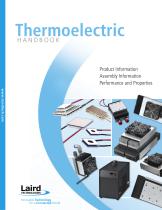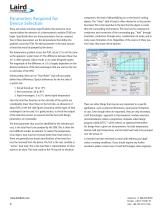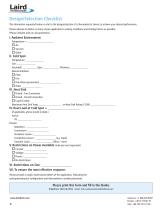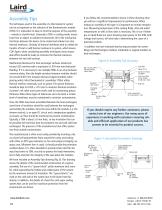
Catalog excerpts

Product Information Assembly Information Innovative Technology
Open the catalog to page 1
Americas: +1.888.246.9050 Europe: +46.31.704.67.57 Asia: +86.755.2714.1166
Open the catalog to page 2
Introduction to Thermoelectrics Solid state heat pumps have been known since the discovery of the Peltier effect in 1834. The devices became commercially available in the 60’s with the development of advanced semiconductor thermocouple materials in combination with ceramics substrates. Thermoelectric modules (TEMs) are solid-state heat pumps that require a heat exchanger to dissipate heat utilizing the Peltier Effect. During operation, DC current flows through the TEM to create heat transfer and a temperature differential across the ceramic surfaces, causing one side of the TEM to be cold,...
Open the catalog to page 3
Figure 1: Cross Section of a typical TE Couple Since thermoelectric cooling systems are most often compared to conventional systems, perhaps the best way to show the differences in the two refrigeration methods is to describe the systems themselves. A conventional cooling system contains three fundamental parts the evaporator, compressor and condenser. The evaporator or cold section is the part where the pressurized refrigerant is allowed to expand, boil and evaporate. During this change of state from liquid to gas, energy (heat) is absorbed. The compressor acts as the refrigerant pump and...
Open the catalog to page 4
In most cases, the cold surface temperature is usually given as part of the problem – that is to say that some object(s) is to be cooled to some temperature. Generally, if the object to be cooled is in direct intimate contact with the cold surface of the thermoelectric, the desired temperature of the object can be considered the temperature of the cold surface of the TEM (Tc). There are situations where the object to be cooled is not in intimate contact with the cold surface of the TEM, such as volume cooling where a heat exchanger is required on the cold surface of the TEM. When this type...
Open the catalog to page 5
Temperature Control When designing a thermoelectric system power supplies, temperature controllers, and temperature sensors are components that also require careful consideration. Thermoelectric devices require a DC power source to operate. The power supply output should be matched to the operational voltage of the thermoelectric modules and fans. Do not operate thermoelectric devices above the specified maximum voltage. Doing so will degrade the operational performance of the TEMs. The power supply should also have a small ripple voltage (maximum of 10% of full output). Ripple voltage is a...
Open the catalog to page 6
To begin selection of a TEM controller, consider the following questions: 1. hat is the maximum voltage & current of TEM used in W application? (also needed for selecting a power supply) 2. Does the system need to Heat, Cool or Heat & Cool? 3. Can the system tolerate a temperature swing of 3°C? Once answered, the selection of the basic functions of a temperature controller can be identified. The controller selected needs to be capable of handling the maximum voltage and current to properly control the TEM and power fans. Other design considerations may exist and should be considered during...
Open the catalog to page 7
Device Selection There are certain minimum specifications that everyone must answer before the selection of a thermoelectric module (TEM) can begin. Specifically there are three parameters that are required. Two of these parameters are the temperatures that define the gradient across the TEM. The third parameter is the total amount of heat that must be pumped by the device. The temperature gradient across the TEM, actual AT is not the same as the apparent, system level AT. The difference between these two ATs is often ignored, which results in an under-designed system. The magnitude of the...
Open the catalog to page 8
Sealant Options Most applications operate in a room temperature environment and cool to below dew point. As a result, moisture in the environment will condense onto the cold side heat exchanger and may accumulate around mounting hardware and eventually penetrate to the TEM. The presence of moisture will cause corrosion that will degrade the useful life of a thermoelectric. Two perimeter sealants are generally used because they provide moisture protection against condensation, have high dielectric strength and low thermal conductivity. Silicone (RTV) is an all purpose sealant that exhibits...
Open the catalog to page 9
Design/Selection Checklist The information requested below is vital to the design/selection of a thermoelectric device to achieve your desired performance. Please attempt to define as many of your application’s existing conditions and limiting factors as possible. (Please indicate units on all parameters.) I. Ambient Environment Temperature = ____________________ o Air o Vacuum o Other Temperature: ______________ Size: ______________ Insulated? ___________Type:_____________Thickness: _____________ Desired Interface: o Plate o Fins o Fluid Flow (parameters) ________________ o Other...
Open the catalog to page 10
Thermoelectric Multistage (Cascade) Modules A multistage thermoelectric module should be used only when a single stage module does not meet control temperature requirements. Figure 4 depicts two graphs: the first shows the ∆T vs. Normalized Power input (Pin/Pmax) of single and multistage modules. The second graphs shows the ∆T vs. COP. COP is defined as the amount of heat absorbed at the cold side of the TEM (in thermal watts) divided by the input power (in electrical watts). These figures should help identify when to consider cascades since they portray the effective ∆T range of the...
Open the catalog to page 11
Assembly Tips The techniques used in the assembly of a thermoelectric system can be as important as the selection of the thermoelectric module (TEM). It is imperative to keep in mind the purpose of the assembly – namely to transfer heat. Generally a TEM, in cooling mode, moves heat from an object to ambient environment. All of the mechanical interfaces between the device to be cooled and ambient are also thermal interfaces. Similarly all thermal interfaces tend to inhibit the transfer of heat or add thermal resistance to system, which lowers COP. Again, when considering assembly techniques...
Open the catalog to page 12All LAIRD TECHNOLOGIES catalogs and technical brochures
-
Board Level Shields Catalog
26 Pages
-
EMI-CAT-Essentials 1213
117 Pages
-
THR-UM-PC-24-TS-58
16 Pages
-
THR-UM-AA-230
8 Pages
-
YS3805
1 Pages
-
YF45018
2 Pages
-
YF880012
2 Pages
-
YF88008
2 Pages
-
YF450112
2 Pages
-
ANT-DS-POE-xxi 0612
2 Pages
-
ANT-DS-POE-XXS-AFI 0712
2 Pages
-
LWS-BRO-Devices 1212
6 Pages
-
IAS-DS-External GPS 0115
2 Pages
-
LWS-LC-ASSET-TRACKING 0310
1 Pages
-
TEL-DS-Internal GPS 0310
2 Pages
-
THR-DS-TC-NTC-2 0413
2 Pages
-
THR-DS-GAPFILLER 0710
2 Pages
-
LT-THR-THIN FILM THERMOELEC 1212
20 Pages
-
THR-DS-UT9,28,F2,4040
2 Pages
-
Laird_Thermoelectric_Module
8 Pages
-
THR-BRO-LCS-012515
6 Pages
-
Power-Over-Ethernet
2 Pages
-
SIAMnet
12 Pages
-
Directional yagi antennas
1 Pages
-
BL620 Series
2 Pages
-
Multi-band Survivor ?
2 Pages
-
Liquid Cooling Systems
6 Pages
-
Ferrite EMI Noise Filtering
8 Pages
-
EMI CATALOG
116 Pages
-
Board Level Shields and Contacts
26 Pages
-
AC4486 - 868MHz Radio Module
3 Pages
-
Client Side Antennas
2 Pages
-
RFID Antennas
18 Pages
-
Ferrite EMI Cable Cores
24 Pages
-
WLAN Antennas
44 Pages
-
GPS/Telematics
8 Pages
-
Thermal Management Solutions
96 Pages
-
Knitted Conductive EMI Gasket
36 Pages
-
EMI ESSENTIALS
36 Pages
Archived catalogs
-
ZB2430 Wireless Modules
3 Pages
-
EMI Capabilities
13 Pages





















































